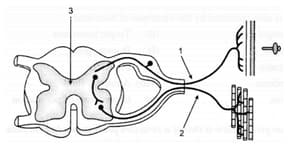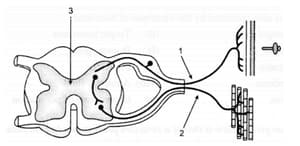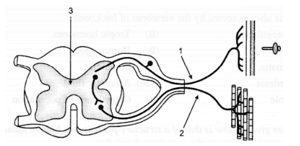At least how many afferent and efferent neurons are involved in any reflex action?
Important Questions on Neural Control and Coordination
The diagram given alongside shows the internal structure of a spinal cord depicting phenomena. Study the diagram and answer the questions:

Name the phenomenon that is depicted in the diagram. Define the phenomenon.
Given below are sets of five terms each. Rewrite the terms in correct order in a logical sequence beginning with the first word that is underlined:
Stimulus, Response, Receptor, Effector, Spinal cord
Choose the ODD one out from the following terms given and name the CATEGORY to which the others belong:
The diagram is given below the internal structure of a spinal cord depicting a phenomenon. Study the diagram and answer the questions.

Mention two ways by which the spinal cord is protected in our body.
The diagram is given below the internal structure of a spinal cord depicting a phenomenon. Study the diagram and answer the questions.

How does the arrangement of neurons in the spinal cord differ from that of the brain?
The diagram is given below the internal structure of a spinal cord depicting a phenomenon. Study the diagram and answer the questions.

Name the parts numbered 1, 2 and 3.
Choose the correct answer from the four options given below:
Which of the following is not a natural reflex action?
| a. | Efferent neuron | b. | Afferent neuron |
| c. | A part of CNS | d. | Receptor |
| e. | Effector | f. | Inter neuron |

